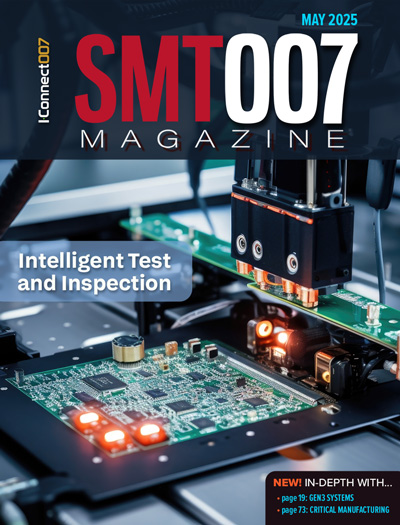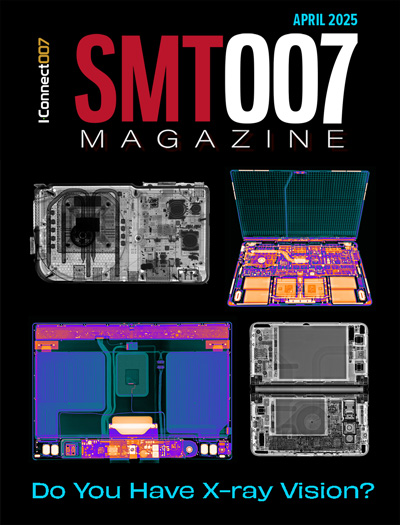-

- News
- Books
Featured Books
- smt007 Magazine
Latest Issues
Current Issue
Intelligent Test and Inspection
Are you ready to explore the cutting-edge advancements shaping the electronics manufacturing industry? The May 2025 issue of SMT007 Magazine is packed with insights, innovations, and expert perspectives that you won’t want to miss.

Do You Have X-ray Vision?
Has X-ray’s time finally come in electronics manufacturing? Join us in this issue of SMT007 Magazine, where we answer this question and others to bring more efficiency to your bottom line.

IPC APEX EXPO 2025: A Preview
It’s that time again. If you’re going to Anaheim for IPC APEX EXPO 2025, we’ll see you there. In the meantime, consider this issue of SMT007 Magazine to be your golden ticket to planning the show.
- Articles
- Columns
Search Console
- Links
- Media kit
||| MENU - smt007 Magazine
Estimated reading time: 4 minutes
The Big Picture: Quality Front-end Engineering as a Core Differentiator
In the PCB industry, high-quality front-end engineering differentiates the top-notch companies from those struggling to keep their customers satisfied. But what determines good quality?
Beginning with careful attention to design specifications, front-end engineers meticulously plan layouts while adhering to industry standards such as IPC guidelines. They employ advanced design software to optimize PCB layouts, focusing on signal integrity, thermal management, and manufacturability. By minimizing signal loss and electromagnetic interference (EMI), front-end engineers lay the groundwork for robust connections and enhanced product reliability. Additionally, they integrate rigorous testing protocols into the front-end process to detect defects early. This is the ultimate determining factor regarding front-end quality: high-performing designs from the outset.
Beyond design considerations, quality engineering in the front-end phase of PCB development extends to supply chain management and customer satisfaction. Front-end engineers collaborate closely with suppliers to establish stringent quality control measures for sourcing materials and components. Through continuous monitoring and improvement initiatives, they ensure the consistency and reliability of raw materials, setting the stage for a successful manufacturing process.
By incorporating feedback mechanisms and data analysis, front-end engineers identify areas for enhancement and drive innovation in PCB design and development. This proactive approach to quality engineering not only meets customer expectations but also fosters a culture of excellence and continuous improvement within the electronics industry.
Attention to detail in front-end engineering procedures and workflow is a core differentiator from the competition. From engineering queries (EQ) to design for manufacturing (DFM) processes, a quality engineering team must manage and track each and every detail. With a proactive approach, PCB brokers can create a personalized customer experience unlike any other.
Three core ways a PCB broker might differentiate themselves include:
- Detailed DFM reviews when a customer is designing a PCB.
- A DFM on every quote, checking for manufacturability and ways to save cost.
- Front-end engineering review/qualification to guide the board to the shop floor.
Providing high quality service is key to any engineering efforts, which involves checking every design and cost detail. This may include identifying and mitigating potential risks as well as reducing costs wherever possible. A top-notch front-end engineering process guarantees that customers will get a well-designed PCB for the best value.
In the best cases, a PCB broker will have an online system where a customer requests a quote or submits a purchase order, which is then entered into the system. It is important that the engineering team handles this customer profile creation, as well as part data preparation, quote engineering analysis, engineering questions handling, and part review.
Throughout this process, a high-quality engineering team should follow a detailed checklist to ensure they have examined all aspects of design when handling engineering questions (EQs). This checklist could include:
- Data read-in
- Customer data read-in and cleanup
- Verify part number and revision
- Previous tooled data read-in (if any)
- Verify all documents and drawing in data package
- Verify previous EQ (if any)
- Verify customer profile
- Browse related emails to verify any special requirement or note
Once all EQs are addressed, then the supply chain management team would send the supplier PO to suppliers. There should be another checklist for the supplier EQ check, as well as for communications with customers.
Transparent communication is essential to quality. Therefore, the supply chain management team, TQ, and account managers should ideally be involved in all EQ communication. Lastly, there should be a data package creation checklist that the engineering team follows to ensure the process is streamlined and efficient for all the parts data.
Critical to the success of each order is the clear communication of the technical aspects of a quote. This is also often handled by the engineering team. Everything from board type to layer count to PCB length and width is accounted for and reviewed. The technical checklist includes dozens of these details for the team to check and confirm.
Two essential ways an engineering team can make a difference for customers are ensuring good quality and lowering cost.
1. Good quality can be guaranteed by:
- Creating a customer profile for general requirements every part so no requirement is missed.
- Clarifying the potential design with the customer to identify fab risks and avoid them during actual fab.
2. Costs may be lowered by:
- Providing design suggestions based on fab capability matrix to reduce the cycles from prototype to validated volume product.
- Suggesting alternate materials and stackup to meet parts’ requirements, optimized panelization to improve material utilization, and stackup structure to optimize productivity.
In the following case study, we can see an engineering team’s abilities to make suggestions that lower cost. It involves a customer who asked for an opinion on having extra buried vias in a new design. While the PCB broker was able to support the design, they explained to the customer that such a design would increase laminating cycles during the manufacturing. This would increase the cost and lower the yield rate due to its complexity. Instead, the engineering team provided the customer with the optimized stackup structure. The customer accepted the suggestion, and the part is now being manufactured without the possible lower yield and higher cost. With the engineering team’s suggestion, this customer saved an estimated 30–50% in costs.
In summary, what makes a PCB broker stand out is an outstanding engineering team, highly detailed procedures, and clear communication with customers. Dedication to front-end engineering gives customers peace of mind that there is a solid foundation for their order to be successful. Quality engineering in the front-end phase of PCB development is foundational to ensuring the reliability and performance of all electronic components. Having an experienced and dedicated front-end engineering team on their side makes all the difference for customers’ PCB quality, and their bottom line.
Mehul J. Davé is chairman of Linkage Technologies, Inc.
More Columns from The Big Picture
The Big Picture: The Shift From China to Southeast AsiaThe Big Picture: What Two Hot Wars Could Mean for the Electronics Supply Chain
The Big Picture: Essential Engineering—The Intersection of Humans and Machines
The Big Picture: How Values Drive Company Culture and Create Trust
The Big Picture: A New Globalization
The Big Picture: The Virtual Via Drum
The Big Picture: Robust Cybersecurity System Means Greater Investment Opportunity
The Big Picture: Cybersecurity—Where Remote Work Gets Really Precarious


